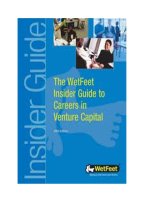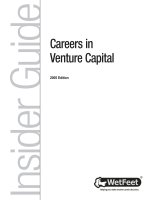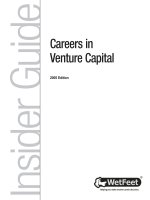Insider Guide Careers in Venture Capital PHẦN 1 ppt
Bạn đang xem bản rút gọn của tài liệu. Xem và tải ngay bản đầy đủ của tài liệu tại đây (130.59 KB, 15 trang )
Insider Guide
Careers in
Venture Capital
2005 Edition
Helping you make smarter career decisions.
WetFeet, Inc.
609 Mission Street
Suite 400
San Francisco, CA 94105
Phone: (415) 284-7900 or 1-800-926-4JOB
Fax: (415) 284-7910
Website: www.wetfeet.com
Careers in Venture Capital
ISBN: 1-58207-442-9
Photocopying Is Prohibited
Copyright 2004 WetFeet, Inc. All rights reserved. This publication is protected by
the copyright laws of the United States of America. No copying in any form is
permitted. It may not be reproduced, distributed, stored in a retrieval system, or
transmitted in any form or by any means, in part or in whole, without the express
written permission of WetFeet, Inc.
Table of Contents
Venture Capital at a Glance . . . . . . . . . . . . . . . . . . . . . . . . . . . . . . 1
The Industry . . . . . . . . . . . . . . . . . . . . . . . . . . . . . . . . . . . . . . . . . . 3
Overview . . . . . . . . . . . . . . . . . . . . . . . . . . . . . . . . . . . . . . . . . . . . . . . . . . . . . . . . . . 4
How Venture Capital Works . . . . . . . . . . . . . . . . . . . . . . . . . . . . . . . . . . . . . . . . . . . 5
A Contemporary History of VC . . . . . . . . . . . . . . . . . . . . . . . . . . . . . . . . . . . . . . . . 9
The State of Venture Capital . . . . . . . . . . . . . . . . . . . . . . . . . . . . . . . . . . . . . . . . . . 11
The Bottom Line . . . . . . . . . . . . . . . . . . . . . . . . . . . . . . . . . . . . . . . . . . . . . . . . . . . 13
How the Industry Breaks Down . . . . . . . . . . . . . . . . . . . . . . . . . . . . . . . . . . . . . . . 14
Industry Rankings . . . . . . . . . . . . . . . . . . . . . . . . . . . . . . . . . . . . . . . . . . . . . . . . . . 17
Industry Trends . . . . . . . . . . . . . . . . . . . . . . . . . . . . . . . . . . . . . . . . . . . . . . . . . . . . 19
The Firms . . . . . . . . . . . . . . . . . . . . . . . . . . . . . . . . . . . . . . . . . . . 23
Profiles of Top Firms . . . . . . . . . . . . . . . . . . . . . . . . . . . . . . . . . . . . . . . . . . . . . . . 24
Firm Thumbnails . . . . . . . . . . . . . . . . . . . . . . . . . . . . . . . . . . . . . . . . . . . . . . . . . . . 70
On the Job . . . . . . . . . . . . . . . . . . . . . . . . . . . . . . . . . . . . . . . . . . 85
The Work. . . . . . . . . . . . . . . . . . . . . . . . . . . . . . . . . . . . . . . . . . . . . . . . . . . . . . . . . 86
Key Jobs. . . . . . . . . . . . . . . . . . . . . . . . . . . . . . . . . . . . . . . . . . . . . . . . . . . . . . . . . . 88
Analysts . . . . . . . . . . . . . . . . . . . . . . . . . . . . . . . . . . . . . . . . . . . . . . . . . . . . . . . . . . 90
Associates and Partners . . . . . . . . . . . . . . . . . . . . . . . . . . . . . . . . . . . . . . . . . . . . . . 95
The Workplace . . . . . . . . . . . . . . . . . . . . . . . . . . . . . . . . . . . . . . 101
Lifestyle and Culture . . . . . . . . . . . . . . . . . . . . . . . . . . . . . . . . . . . . . . . . . . . . . . . 102
Hours . . . . . . . . . . . . . . . . . . . . . . . . . . . . . . . . . . . . . . . . . . . . . . . . . . . . . . . . . . . 103
Workplace Diversity . . . . . . . . . . . . . . . . . . . . . . . . . . . . . . . . . . . . . . . . . . . . . . . . 104
Travel . . . . . . . . . . . . . . . . . . . . . . . . . . . . . . . . . . . . . . . . . . . . . . . . . . . . . . . . . . . 106
Compensation . . . . . . . . . . . . . . . . . . . . . . . . . . . . . . . . . . . . . . . . . . . . . . . . . . . . 107
Career Notes . . . . . . . . . . . . . . . . . . . . . . . . . . . . . . . . . . . . . . . . . . . . . . . . . . . . . 109
Insider Scoop . . . . . . . . . . . . . . . . . . . . . . . . . . . . . . . . . . . . . . . . . . . . . . . . . . . . . 110
How VC Stacks Up . . . . . . . . . . . . . . . . . . . . . . . . . . . . . . . . . . . . . . . . . . . . . . . . 115
A VC’s View. . . . . . . . . . . . . . . . . . . . . . . . . . . . . . . . . . . . . . . . . . . . . . . . . . . . . . 117
Getting Hired. . . . . . . . . . . . . . . . . . . . . . . . . . . . . . . . . . . . . . . . 119
The Recruiting Process . . . . . . . . . . . . . . . . . . . . . . . . . . . . . . . . . . . . . . . . . . . . . 120
What It Takes. . . . . . . . . . . . . . . . . . . . . . . . . . . . . . . . . . . . . . . . . . . . . . . . . . . . . 123
Breaking In. . . . . . . . . . . . . . . . . . . . . . . . . . . . . . . . . . . . . . . . . . . . . . . . . . . . . . . 126
Interviewing Tips . . . . . . . . . . . . . . . . . . . . . . . . . . . . . . . . . . . . . . . . . . . . . . . . . . 127
Getting Grilled. . . . . . . . . . . . . . . . . . . . . . . . . . . . . . . . . . . . . . . . . . . . . . . . . . . . 128
Grilling Your Interviewer. . . . . . . . . . . . . . . . . . . . . . . . . . . . . . . . . . . . . . . . . . . . 130
For Your Reference . . . . . . . . . . . . . . . . . . . . . . . . . . . . . . . . . . . 133
Industry Lingo . . . . . . . . . . . . . . . . . . . . . . . . . . . . . . . . . . . . . . . . . . . . . . . . . . . . 134
For Further Study . . . . . . . . . . . . . . . . . . . . . . . . . . . . . . . . . . . . . . . . . . . . . . . . . 140
Online Resources . . . . . . . . . . . . . . . . . . . . . . . . . . . . . . . . . . . . . . . . . . . . . . . . . . 142
The Final Word . . . . . . . . . . . . . . . . . . . . . . . . . . . . . . . . . . . . . . . . . . . . . . . . . . . 143
Venture Capital at a Glance
Opportunity Overview
• The venture capital industry is small and hires only a select few each year.
Traditionally dominated by seasoned executives, many firms consist only of
general partners and an administrative staff.
• A bleak picture for undergrads, though a few larger firms hire young people
to do some of their basic legwork and analysis.
• Not much better for MBAs, though a few recent MBAs have been recruited
right out of business school or have even started their own funds.
• Some opportunities for midcareer professionals with an excellent track record
in operating environments, since venture capitalists want seasoned industry
veterans with bulging networks and specialized knowledge.
Major Pluses about Careers in Venture Capital
• Work with some of the smartest people in business.
• Witness the formation of cutting-edge businesses and technologies.
• Be relatively sheltered from politicking and favoritism—it’s the bottom line
that counts.
• Over the life of a fund, make potentially dizzying amounts of money.
Major Minuses about Careers in Venture Capital
• Sink or swim. If you don’t produce, you’ll be kicked out, with skills that are
hard to transfer.
• Little upward mobility. Advancing to partner level is difficult.
• Not a popularity contest. The entrepreneurs will not always love you.
• VC can be a lonely business. Many insiders miss the sense of teamwork
within their companies.
1
At a Glance
Recruiting Overview
The basic idea: “Don’t call us; we’ll call you.” Firms rarely interview on campus
but will occasionally go through business schools’ resume books. However, your
resume alone won’t be enough. Venture capital firms are reluctant to hire someone
they don’t know from previous business dealings unless they have a strong
recommendation from a trusted business associate. The industry is small and
firms are very choosey.
2
At a Glance
The Industry
• Overview
• How Venture Capital Works
• A Contemporary History of VC
• The State of Venture Capital
• The Bottom Line
• How the Industry Breaks Down
• Industry Rankings
• Industry Trends
3
The Industry
Overview
Sand Hill Road, a sedate four-lane suburban byway, climbs from the Stanford
University Golf Course into the coastal hills. On either side, low office buildings
cluster behind signs that read The Mayfield Fund, Sequoia Capital, and Kleiner
Perkins Caufield & Byers. These inconspicuous offices are the heart of the
venture capital industry, where companies like Apple, eBay, Sun Microsystems,
and Yahoo got the start-up money and advice that helped make them Silicon
Valley legends.
The industry is a major shaker in the U.S. economy, funding companies developing
technological and service innovations long before they become mainstream. A
study by DRI-WEFA, an economic consulting firm, showed that from 1970 to
2000, venture capital-backed companies had approximately twice the sales, paid
almost three times the federal taxes, generated almost twice the exports, and
invested almost three times as much in R&D as the average non–VC-backed
public company, per each $1,000 of assets. These are impressive results indeed
for what insiders describe as a “cottage” industry.
While VC firms are major shakers in the economy, they aren’t major recruiters.
General partners within the VC industry garner wealth and satisfaction funding
companies in nascent industries and watching them grow, but breaking into the
industry is notoriously difficult. This guide provides a roadmap for those who
choose to try.
4
The Industry
How Venture Capital Works
Underneath their moneyed mystique, venture capitalists are essentially glorified
middlemen, and their modus operandi is easily explained. In a nutshell, a VC firm
acts as a broker for institutional or “limited partner” investors such as pension
funds, universities, and high-net-worth individuals, all of whom pay annual man-
agement fees to have their money invested in high-risk, high-potential-yield start-
up companies.
After amassing a certain sum from the limited partner investors—usually between
$10 million and $1 billion—the VC firm parcels out the fund to a portfolio of
fledgling private companies, each of which hands over an equity stake in its
business. In other words, the VC industry is predicated on a simple swap of the
VC’s financing for an ownership stake in the company’s success, often (but by
no means always) before the company has begun generating revenue.
Since the VC firm has a vested interest in its start-ups’ success, partners will
generally sit on several boards of directors, offering advice and additional
resources to help businesses grow. In the event that one of its start-ups merges
with or is bought out by a larger company or goes public, any windfall is divvied
up between the company, the VC firm, and the limited partner investors. Typically,
the VC firm distributes 70 to 80 percent of the return on its investments to the
various limited partners and keeps the rest for itself.
A Game of Risk
Aside from the prospect of stumbling upon the next eBay, what makes venture
capital so exciting is that it comes with no guarantees. Venture capitalists, institutional
investors, and entrepreneurs must all be wary of the risk incurred by investing
5
The Industry
in start-ups. Although it’s not unusual for limited partners to double their money
through venture investments, they generally entrust only a small portion of their
total assets to the VC firm, so that if the fund tanks, they’ll remain solvent.
On the other end of the deal, entrepreneurs who accept venture capital often
have to contend with pressure from their VCs, who have their own ideas about
what’s best for the start-up. VC-funded companies that manage to get off the
ground must go through several grueling rounds of fundraising to make it to
an IPO. Even then, there’s a chance that they’ll flop. The savviest venture
capitalist must be patient if he or she hopes to turn a couple of entrepreneurs
in a garage into a publicly traded company. VCs can generally expect to stick
around for 4 to 7 years before realizing a return on their investment.
The Entrepreneur’s Perspective
Even though VCs like to imagine themselves as the heroes of the entrepreneurial
world, entrepreneurs often have a different view. To give you a feel for this love-
hate dynamic, we interviewed an entrepreneur about her experience working with
VC investors. This is her story:
Shelly (her name has been changed) thought up a great idea for a business, put
together a business plan, borrowed some money from her family to get the
business going, and worked with contract employees and suppliers to develop
a prototype product. She quickly realized she would need more capital.
Using contacts she made in graduate school, Shelly sought advice and potential
investors. She originally targeted private investors, but a VC who was reviewing
her plan called her out of the blue and said he would match any private financier’s
offer. Shelly quickly went for the VC money because she knew funding from
the VC firm would bring prestige and credibility and make it much easier to
raise future rounds of financing.
6
The Industry
Why did the VCs select her project out of the thousands of proposals they received
that year? According to Shelly, they believed she had the skills and personality to
make it as an entrepreneur. Also, she was introduced to her investor by a very credible
source, probably someone well known to the investor. (A note of caution: Shelly
says that just sending in a proposal to a venture capital firm is the kiss of
death.)
Negotiations over terms went very smoothly, except for a small wrangle over
dilution of stocks. She said that the lesson here is that, once the initial terms are
laid out, VCs will try to do anything to protect their price.
As soon as Shelly got her money, she began hiring. The company started getting
good press and was putting its product development into high gear. The VCs
were pleased and kept pushing her to hire faster and grow as quickly as possible.
Shelly saw that she was going to run out of money if she kept growing at this
rate, so she got a bridge loan to last her the several months until the next
valuation.
Nine months after the first round, Shelly’s board decided that they needed a
new round of venture investment. This time, they got offers from multiple firms,
but all at the same low valuation, suggesting to Shelly that VC firms talk to each
other when bidding on the same company. She chose firms that were allied
with strategic partners and closed a deal with the partner at the same time that
she closed the financing.
Armed with more money, the business started growing and hiring continued, but
problems cropped up. Many of the early employees hired by the board didn’t work
out, and turnover increased. Meanwhile, the company’s management thought
that the VC firm’s attention was directed elsewhere. Indeed, they complained
that the VC’s added value was limited mostly to headhunter introductions.
7
The Industry
As the company raised an additional and substantially larger round of funding
from an outside group of companies, at a much higher valuation, relations with
the management team and original VC firm worsened. Despite the fact that
these second-round companies had provided much more funding, the original
VCs held the balance of power on the board (a common frustration at many
VC-funded companies).
When sales for the next period came in below forecast, things turned ugly. The
company cut staff, and after a period of contentious wrangling between the
senior management team (which included a number of people brought in by the
board) and Shelly, she gave an ultimatum: “Get rid of some of the executives, or
I’m out.” The board backed the other executives, and Shelly left but retained
her seat on the board.
When the company was flying highest, it looked as if a public offering or
acquisition was on the horizon. These opportunities disappeared when the
company ran into problems, but the game is not over yet. The firm may still
reach liquidity if it is able to retrench.
Shelly offers the following advice for others working with venture capital firms:
• It’s a great way to go, but make sure you research your VC firm and board
members carefully. Conduct due diligence on them the way you would with
top hires.
• Understand that there are times when you and your VCs will have different
motivations. VCs are happy only if the company goes public or is acquired;
but for an entrepreneur, not selling out to another company can produce
very significant returns. VCs have a portfolio strategy and want to increase
their stake by growing very quickly so that winners will pay off in a big way.
• Don’t let your VCs push you around. In the end, the company is your
creation—and your responsibility.
8
The Industry
A Contemporary History of VC
From 1980 to 1995, VCs raised from $2 billion to $4 billion a year. In the
late 1990s, the number and size of venture-backed IPOs soared, reflecting the
tremendous performance of the Nasdaq. Rates of return, which had quadrupled
for venture-backed companies, seduced even the top VC veterans into a gold-
rush mentality. In 2000, some 20 firms were raising $1 billion funds, thinking
the Internet bubble would not burst. There was competitive pressure to do
more deals, grow portfolio companies fast, and get them to market as quickly
as possible. Suddenly, an industry that had been small for years was huge.
In 2000, VC investments reached a peak of $68.8 billion, up 80 percent from
the $35.6 billion invested in 1999. VCs seemed constitutionally unable to do
wrong. From 1996 to 2001, the number of venture capital funds grew nearly
60 percent, from 422 to 669. In 2000, the year in which the industry peaked,
more than 8,000 companies divided more than $106 billion. Then the bubble
popped and the VC industry contracted.
In the fourth quarter of 2000, VCs saw the first negative quarterly return for
the industry (–6.3 percent) since 1998. Then, from 2000 to 2001, venture
investments dropped 65 percent as the stock market downturn slammed the
lucrative IPO window shut and slashed the valuations of both public and
private companies. In 2002, VCs made 3,042 deals compared to 4,643 deals in
2001; this number was barely more than half ($21.2 billion) as much as was
invested in 2001.
The VC industry felt the pinch. A number of leading firms reduced the size of
their funds, actually returning money to investors. Investment banks, including
9
The Industry
Goldman Sachs, Deutsche Bank, and Banc of
America Securities shut down their Silicon Valley
offices. A few investors invoked clawbacks, contractual
obligations that require venture capitalists to pay back
the investor’s principle before it could keep the fund’s
profits.
In 2003, the contraction continued, with $18.2
billion invested in 2,715 companies, a 15 percent
decline over 2002. But many in the VC world saw
these as necessary changes, bringing the industry
back into balance. In 2003, an insider explained
the changes this way: “I think the important aspect
is that while there’s still too much money, which
causes overfunding, our industry is back to work
this year. People are investing in new and exciting
technology run by seasoned entrepreneurs. I think if you were to look at our
industry, we’re cautiously optimistic. I think the real barrier continues to be
corporate capital expenditures. In effect, for our industry to grow, large companies
need to do well. We’re just starting to see that. My best companies are starting
to do well. The quality of everyone in the food chain has gone up dramatically.
Management teams are better. Entrepreneurs are better. Venture capitalists are
consolidating their positions. I think it’s really important today to be connected
with a top-tier firm.”
10
The Industry
The quality of
everyone in the
food chain has
gone up dramatically.
Management
teams are better.
Entrepreneurs are
better. Venture
capitalists are
consolidating their
positions. It’s really
important today to
be connected with
a top-tier firm.
“ ”
The State of Venture Capital
During the last 3 months of 2003, venture funds claimed their first positive
return in 3 years. Investments in 2003 appeared more stable than in previous
years, with the IPO market showing signs of a comeback. From January to
March of 2004, 32 VC funds raised $2.3 billion, the highest first quarter total
since 2001. And in the first quarter of 2004, M&A activity was up 75 percent,
with 77 companies merging or being acquired for $4 billion.
In 2004, optimism is again gaining ground—and the opportunities for enterprising
entrepreneurs and MBAs are on the upswing. “Where I think we are is at a place
in the industry where the existing funds are out actively investing, there is some
new fund formation, there is still an oversupply of capital in our system,” says
an insider. “The employment picture for startups is improving. There’s a bunch
of people out there doing searches, more at the senior level than at the junior
level. But I think one trails the other. The firms are building capacity at the partner
level now, and you can see from the dollars put to work, the industry has hit a
plateau at about $16 or $17 billion in investments.”
“I think it’s a decent time to be investing,” says an insider. “I think in retrospect,
you look at a period like ’95 to ’97, that was an excellent period. I think this is a
good period. You get rewarded for building a real company with a real management
team. If the public markets are closed for a long time to new companies, you
get a logjam. Entrepreneurs must believe they can realize value. You don’t want
things to get too hot or too cold. You want things to be on a steady uptick. I
think the outlook is quite positive. A whole lot of things are getting back in
alignment.”
11
The Industry









